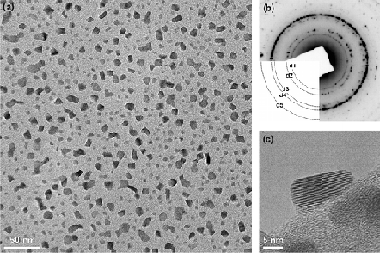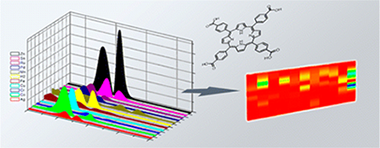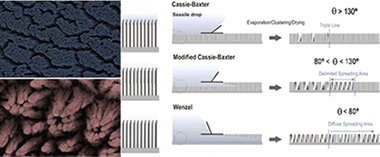Artículos SCI
2012
2012
Nanotecnología en Superficies y Plasma
DLC coatings for UHMWPE: Relationship between bacterial adherence and surface properties
Del Prado, G; Terriza, A; Ortiz-Perez, A; Molina-Manso, D; Mahillo, I; Yubero, F; Puertolas, JA; Manrubia-Cobo, M; Barrena, EG; Esteban, JJournal of Biomedical Materials Research Part A, 100A (2012) 2813-2820
Show abstract ▽

Development of intrinsically antibacterial surfaces is of key importance in the context of prostheses used in orthopedic surgery. This work presents a thorough study of several plasma-based coatings that may be used with this functionality: diamond-like carbon (DLC), fluorine-doped DLC (F-DLC), and a high-fluorine-content-carbon-fluor polymer (CFX). The coatings were obtained by a radio-frequency plasma-assisted deposition on ultra high molecular weight polyethylene (UHMWPE) samples and physicochemical properties of the coated surfaces were correlated with their antibacterial performance against collection and clinical Staphylococcus aureus and Staphylococcus epidermidis strains. The fluorine content and the relative amount of CC and CF bonds were controlled by X-ray photoelectron spectroscopy, and hydrophobicity and surface tension by contact angle measurements. Surface roughness was studied by Atomic Force Microscopy. Additional nanoidentation studies were performed for DLC and F-DLC coatings. Unpaired t test and regression linear models evaluated the adherence of S. aureus and S. epidermidis on raw and coated UHMWPE samples. Comparing with UHMWPE, DLC/UHMWPE was the least adherent surface with independence of the bacterial species, finding significant reductions (p ≤ 0.001) for nine staphylococci strains. Bacterial adherence was also significantly reduced in F-DLC/ UHMWPE and CFx/UHMWPE for six strains. © 2012 Wiley Periodicals, Inc. J Biomed Mater Res Part A 100A:2813–2820, 2012.
Octubre, 2012 | DOI: 10.1002/jbm.a.34220
Reactividad de Sólidos
Mechanochemical synthesis and characterization of nanocrystalline BiSe, Bi 2Se 3 semiconductors
Achimovicova, M; Gotor, FJ; Real, C; Daneu, NJournal of Materials Science: Materials in Electronics, 23 (2012) 1844-1850
Show abstract ▽

Mechanochemical synthesis of bismuth selenides (BiSe, Bi 2Se 3) was performed by high-energy milling of bismuth and selenium powders in a planetary ball mill. The particle size distribution and the specific surface area of Bi/Se and 2Bi/3Se powder mixtures were analysed at increasing milling time. The products were characterized by X-ray diffraction, differential scanning calorimetry and transmission electron microscopy. The presence of bismuth selenide phases was observed after only 1 min of milling and full conversion into hexagonal BiSe phase (nevskite) and rhombohedral Bi 2Se 3 phase (paraguanajuatite) was reached after 10 min of milling. The nanocrystalline nature of both mechanochemically synthesised bismuth selenides was confirmed and their optical band gap energies were obtained on the basis of the recorded absorption spectra in UV-Vis spectral region.
Octubre, 2012 | DOI: 10.1007/s10854-012-0672-2
Nanotecnología en Superficies y Plasma
Selective Detection of Volatile Organic Compounds by Spectral Imaging of Porphyrin Derivatives Bound to TiO2 Porous Films
Roales, J; Pedrosa, JM; Castillero, P; Cano, M; Richardson, TH; Barranco, A; Gonzalez-Elipe, ARACS Applied Materials & Interfaces, 4 (2012) 5147-5154
Show abstract ▽

In this work, the carboxylic acid derivatives of a free-base porphyrin, 5,10,15,20-tetrakis(4-carboxyphenyl)-21H,23H-porphyrin, and 10 of its metal derivatives (TCPPs) have been used for optical gas sensing. For this purpose, microstructured columnar TiO2 thin films prepared by GAPVD (glancing angle physical vapor deposition) have been used as host materials for the porphyrins as they are non–dispersive and porous, allowing their use for UV–visible spectroscopy and gas sensing. The chemical binding between the dye molecules and the TiO2 has been studied through infrared spectroscopy, and the obtained spectral changes have been found to be compatible with chelating and/or bidentate binding modes of the carboxylate groups on the TiO2 surface. When hosted in the film, the UV–visible spectra of the porphyrins featured a blue shift and broadening of the Soret band with respect to the solution, which has been attributed to the formation of π–π aggregates between porphyrin molecules. The composite porphyrin/TiO2 films obtained from each of the 11 porphyrins have been exposed to 12 different volatile organic compounds (VOCs), and their respective gas–sensitive properties have been analyzed as a function of the spectral changes in their Soret band region in the presence of the analytes. The set of composite films has shown high selectivity to the analyzed volatile compounds. For each analyte, an innovative way of showing the different responses has been developed. By means of this procedure, an imagelike recognition pattern has been obtained, which allows an easy identification of every compound. The kinetics of the exposure to several analytes showed a fast, reversible and reproducible response, with response times of a few seconds, which has been attributed to both the sensitivity of the porphyrins and the high porosity of the TiO2 films. Also, increasing concentrations of the analytes resulted in an increase in the magnitude of the response, indicating that the sensor behavior is also concentration-dependent.
Octubre, 2012 | DOI: 10.1021/am301069
Nanotecnología en Superficies y Plasma
Following the Wetting of One-Dimensional Photoactive Surfaces
Macias-Montero, M; Borras, A; Alvarez, R; Gonzalez-Elipe, ARLangmuir, 28 (2012) 15047-15055
Show abstract ▽

This article aims toward a full description of the wetting conversion from superhydrophobicity to superhydrophilicity under illumination with UV light of high-density ZnO nanorods surfaces by (i) following the evolution of the clusters and superstructures formed by the nanocarpet effect as a function of the water contact angle (WCA); (ii) characterization of the superhydrophobic and superhydrophilic states with an environmental scanning electron microscope (ESEM); and (iii) using the nanocarpet effect as a footprint of both local and apparent water contact angles. Thus, the main objective of the article is to provide a general vision of the wettability of 1D photoactive surfaces. In parallel, the nanocarpet (NC) formation by clustering of vertically aligned ZnO nanorods (NR) when water is dripped on their surface and then dried is studied for the first time by taking advantage of the possibility of tuning the surface water contact angle of the ZnO NR structure under UV preillumination. As a result, we demonstrate the feasibility of controlling the size and other morphological characteristics of the NCs. Moreover, a strong anisotropic wetting behavior, characterized by a Δθ = θ – θ = 30°, is shown on an asymmetrically aligned NC surface resulting from arrays of tilted NRs. The study of the condensation/evaporation of water on/from an as-prepared (superhydrophobic) or a preilluminated (superhydrophilic) NR surface examined by an environmental scanning electron microscope has evidenced the formation of supported water droplets with polygonal shapes in the first case and the complete filling of the inter-NR space in the latter. The long-term stability of the NC clusters has been utilized as a footprint to track the penetration depth of water within the inter-NR space in the three borderline regions of water droplets. This analysis has shown that for moderately hydrophobic surfaces (i.e., water contact angles lower than 130°) water droplets do not present a well-defined borderline trace but a spreading region where water penetrates differently with the NR interspace. The transition from a Cassie–Baxter to a modified Cassie–Baxter to finish in a Wenzel wetting state is found on these surfaces depending on the UV preillumination time and is explained with a model where water interaction with the NR units is the critical factor determining the macroscopic wetting behavior of these surfaces.
Octubre, 2012 | DOI: 10.1021/la3028918
Materiales Nanoestructurados y Microestructura
Microstructural characterization of hydrophobic Ti1−xAlxN coatings with moth-eye-like surface morphology
Godinho, V; Lopez-Santos, C; Rojas, TC; Philippon, D; de Haro, MCJ; Lucas, S; Fernandez, AJournal of Alloys and Compounds, 536 (2012) S398-S406
Show abstract ▽

Ti1−xAlxN thin films with different Al content were deposited by magnetron sputtering. The combination of electron energy loss spectroscopy (EELS) and energy dispersive spectroscopy (EDS) was used to evaluate the composition of the coatings. The effect of Al content on the morphology and properties of the coatings was investigated. High resolution electron microscopy and related techniques revealed the formation of a pillared moth-eye-like nanostructure with variable size and distribution of meso- and nano-columns and different degree of open porosity that depends on the Al content on the coating. For low Al content (x ≤ 0.21) c-(Ti,Al)N highly porous columns ending in a sharp pyramidal shape present low reflectivity and high hydrophobicity. While the precipitation of h-AlN phase at the column boundaries for x = 0.71 suppresses the c-(Ti,Al)N columnar growth and produces a smother surface, with higher reflectivity and less hydrophobic character.
Septiembre, 2012 | DOI: 10.1016/j.jallcom.2012.02.178
- ‹ anterior
- 321 of 422
- siguiente ›














